2015 Sea-Doo GTX S 155 Review
Sea-Doo's affordable suspension option
Rough water may look fun to the novice personal watercraft rider, but unless there are waves to actually jump and not just pound over, riding in everyday chop gets old fast; especially for passengers. Do it often and you’ll want to have your local massage therapist on speed dial.
Sea-Doo’s solution to the problem – giving a PWC an actual suspension – remains the only true attempt to date at addressing the issue. It’s featured in its manual, more affordable iteration in the GTX S 155.
Divide and Conquer
Whether “intelligent” or manual, the suspension concept is essentially the same. To soften the ride, designers split the upper half of the watercraft (including saddle, footwells, and handlebars) from the lower hull, joining the two halves with a twin-arm suspension and centrally located spring and shock absorber. When compressed, the upper portion lowers into the outer hull by about five-and-a-half inches, an amount of travel you can actually see by simply hopping up and down in the footwells. It’s enough to soften the jolt of rough water and make the ride that much more pleasant for all in the saddle, but especially those passengers who don’t have a handlebar to brace against or, in many cases, the forward vision to see those waves coming.
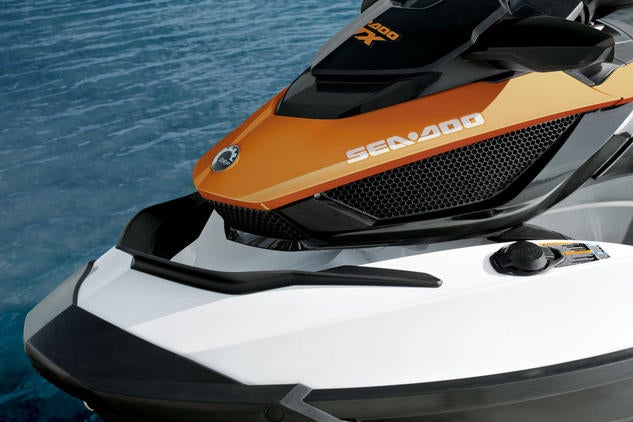 The top half of the GTX S 155 is separated from the bottom half and joined by a suspension system that helps cushion the ride.
The top half of the GTX S 155 is separated from the bottom half and joined by a suspension system that helps cushion the ride.Sea-Doo’s initial suspension concept was computer-driven, and featured on its flagship cruiser. It set the amount of shock absorption by responding to the weight in the saddle at startup. The GTX S 155 lacks that “intelligent” component, but brings the basics to a lower horsepower, more affordable model. Suspension is set by the owner by simply tightening or loosening the system with a standard socket wrench via a bolt accessed below the seat. Tighten it for a stiffer feel, or loosen it to soften the ride.
COMPARISON: Read our review of the 2015 Yamaha VX Cruiser
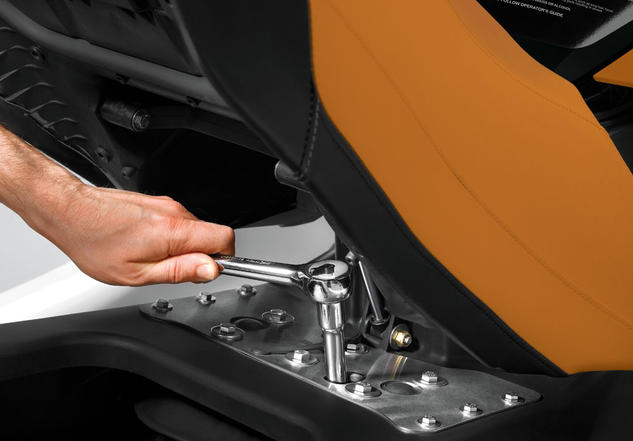 Adjusting the tension of the suspension involves lifting up the seat and adjusting a bolt with a socket wrench.
Adjusting the tension of the suspension involves lifting up the seat and adjusting a bolt with a socket wrench.Why would owners want a stiffer suspension? A performance-minded rider, in tough conditions, won’t want the saddle and footwells to bottom out, or hit their limit with a jolt. Touring-oriented riders, meanwhile, may appreciate the softer, cushier feel of a looser suspension. You can also adjust the tension to match your typical passenger load or the severity of your local waters.
Versatile Platform
That manual suspension is the only component that truly separates the S from the basic GTX 155. As such, you’ll still get the familiar and versatile GTX hull, with its deep-V already solid at busting through chop and softening the ride. That hull carves exceptionally well, giving this larger craft the feel of a smaller ride. The ergonomics up top are also nicely done, with comfort and an everything-in-the-right-place feel.
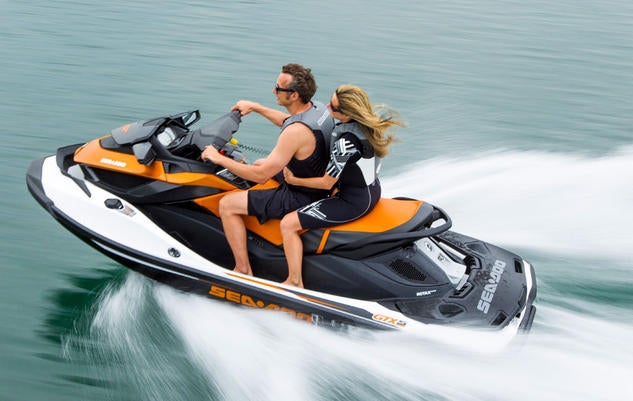 The familiar GTX hull provides a confident and comfortable ride.
The familiar GTX hull provides a confident and comfortable ride.The obvious drawback is that suspension, whether in automatic or manual form, takes up considerable space. That reduces storage capacity considerably, with only a minimal 16.4 gallons available to stow your gear.
COMPARISON: Read our review of the 2014 Kawasaki Jet Ski Ultra LX
Power, however, has no such shortcomings. The 155hp variant of Sea-Doo’s 1,494cc Rotax may rely strictly on its displacement and not an additional supercharger to deliver its power, but it’s still delivers a top speed around 56 mph and enough low-end grunt to pull skis, tubes, wakeboards and the like. Use the electronic trim system to lower the bow for quicker starts off the bottom end, and raise it to enhance top speed.
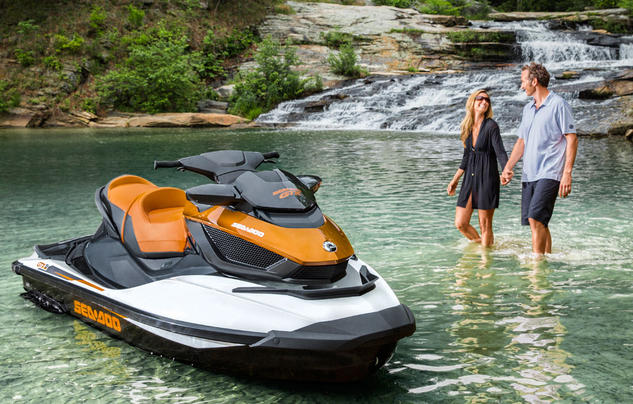
The S gets the standard Sea-Doo feature list, including both Intelligent Brake & Reverse and Intelligent Throttle Control. iBR should be nothing new at this point of its existence, but for the uninitiated, it provides stopping power by linking a spoiler and reverse bucket to a left-handlegrip lever. Squeeze it at speed to lower the spoiler and create drag, rapidly slowing the boat before thrust kicks in to finish the job. Use it at low speed to mimic the feeling of gears, “shifting” the boat between forward, neutral and reverse without ever taking your eyes off the water. iBR also lets all Sea-Doos start in neutral, with no sudden surge of thrust as the engine comes to life.
Intelligent Throttle Control allows for differing acceleration profiles. Cruising riders or newcomers may prefer the tamer response of Touring mode; performance riders will want to opt for the full acceleration potential of Sport mode. An ECO mode can also be activated to conserve fuel.
Throttle-by-wire also makes possible cruise control, great for touring and tow sports, as well as no-wake mode. Both eliminate the need to continually adjust pressure on the throttle and therefore prevent finger, hand, and arm fatigue, plus a lot of frustration.
COMPARISON: Read our review of the 2015 Kawasaki Ultra LX vs. Sea-Doo GTX 155 vs. Yamaha FX HO
New for 2015 is a modification to the Learning Key lanyard. The system – which includes a separate lanyard that can limit speed – now features a Radio Frequency (RF) ball-and-socket connection. Returning favorites include tilt steering, fold-down boarding step, and a bolstered saddle with plenty of back support.
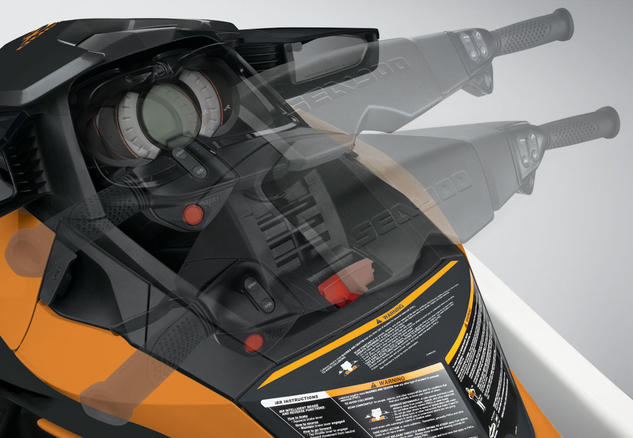 Tilt steering offers a comfortable setting for riders of many sizes.
Tilt steering offers a comfortable setting for riders of many sizes.Soften the Blows…and the Price
With the Sea-Doo GTX S 155 as its core, it’s clear the decision comes down to how highly you value suspension. If you live in a coastal area, or on a large lake or frequently traveled river, it’s worth a test ride. Suspension lessens the fatigue of a rough ride, and is almost guaranteed to keep your passengers happier.
It comes at a price, naturally. But thanks to the primary elements of Intelligent Suspension trickling down to this lower-end model, it’s a price that’s now within reach of far more consumers.
| 2015 Sea-Doo GTX S 155 Specs | |
| Length | 139.2 inches |
| Beam | 48.2 inches |
| Curb Weight | 1,010 lbs |
| Engine | Naturally aspirated three-cylinder |
| Displacement | 1,494 cc |
| Bore and Stroke | 100 mm x 63.4 mm |
| Compression Ratio | 10.6:1 |
| Rated Horsepower | 155 |
| Fuel Capacity | 18.6 gal. |
| Combined Stowage Capacity | 16.4 gal. |
| Colors | White & Alloy Orange |
| Price | $13,399 |
Get PersonalWatercraft.com in your Inbox!
Like PersonalWatercraft.com on Facebook
Comments
Most Popular

2025 Yamaha JetBlaster PRO 2-Up Review

Remembering the Sea-Doo XP

2024 Kawasaki Jet Ski STX 160X Review

Whatever Happened to the Wetbike?

2025 Yamaha JetBlaster Review




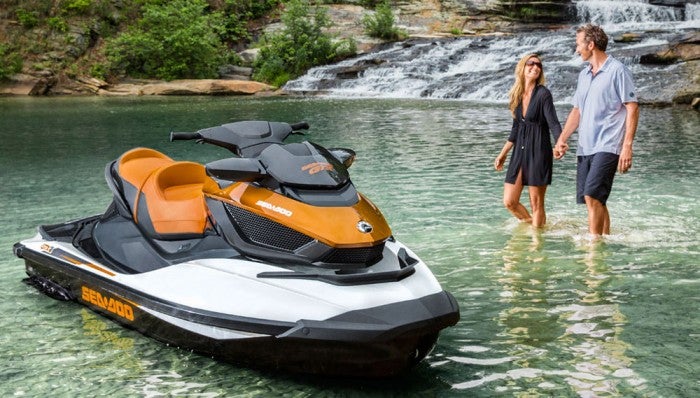
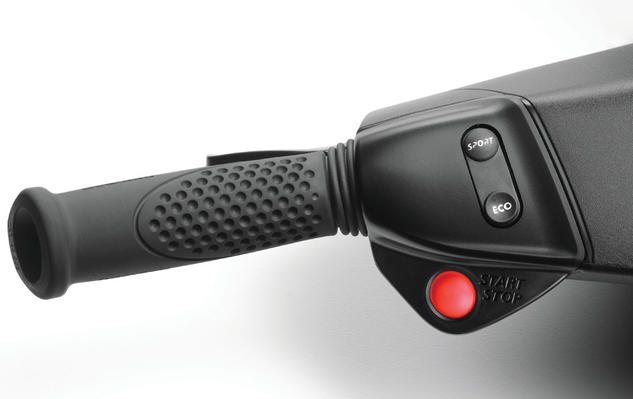









 Your Privacy Choices
Your Privacy Choices